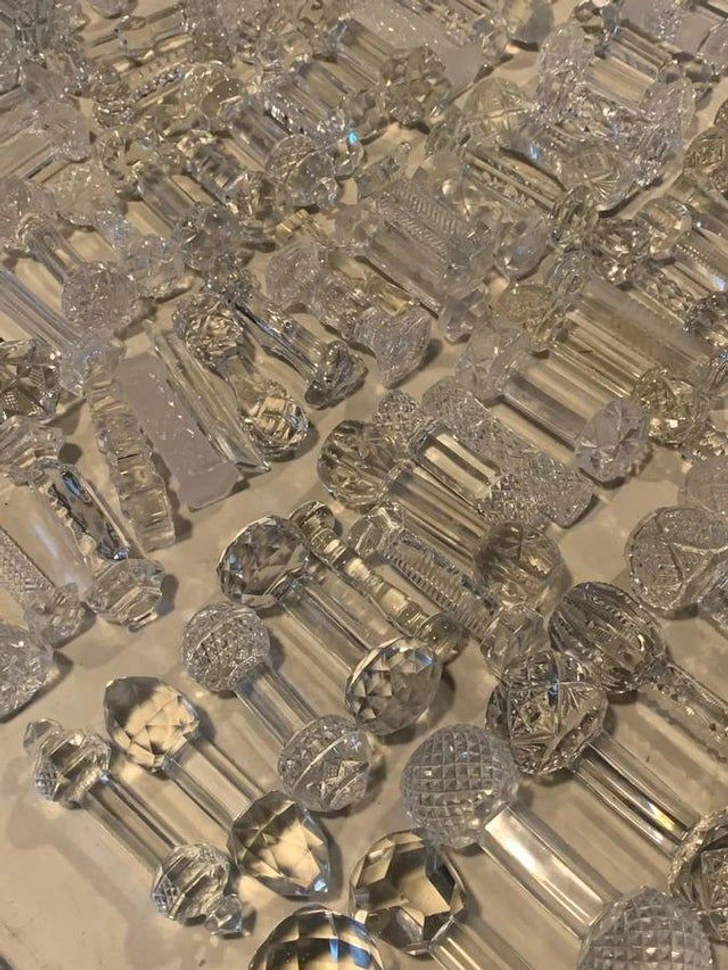I saw these glass items at a yard sale. They aren’t doorknobs and some look like one solid piece.

Answer: “These are knife rests.”
In the world of tableware and dining etiquette, certain elements have stood the test of time — crystal glasses, porcelain plates, polished silver cutlery. Yet, one subtle but elegant accessory has faded into the background of modern table settings: the knife rest.
For those unfamiliar, a knife rest is a small implement, traditionally used to keep knives (and occasionally forks) off the table surface between courses. Though seemingly minor, it plays a significant role in maintaining both cleanliness and the integrity of an elegant table arrangement.
But what are knife rests, really? Where did they originate, and why are they making a quiet return to fine dining experiences today? Let’s explore this fascinating, often-overlooked table tool in depth.
What Is a Knife Rest?
A knife rest is a small object — typically made from materials such as metal, porcelain, glass, crystal, or wood — designed to hold the blade of a knife slightly elevated from the tablecloth or placemat. The purpose? To prevent grease, sauces, or food residue from staining the table, and to avoid cross-contamination between courses.
Knife rests usually have two “arms” or ends where the knife handle and blade can be balanced, ensuring the utensil doesn’t touch the surface of the table. They’re both functional and ornamental, often designed to complement the rest of the table décor.
A Brief History of Knife Rests
The knife rest’s history can be traced back to 18th-century Europe, particularly in aristocratic households in France and England. During multi-course meals — sometimes stretching into the double digits — guests were expected to reuse their utensils. Knife rests were introduced as a sanitary and aesthetic solution to prevent dirty cutlery from resting directly on pristine linens.
In Victorian England, the use of knife rests became an essential part of formal table settings. They were seen not just as practical, but as a symbol of refinement and hospitality. Many knife rests from this period were elaborately crafted and are now sought-after collector’s items.
However, by the mid-20th century, the tradition of using knife rests declined as table etiquette became more relaxed and dishwashing became automated. The idea of reusing cutlery between courses also waned, leading to the gradual disappearance of this elegant tool from everyday tables.
The Modern Revival of Knife Rests
In recent years, as home dining and fine entertaining have experienced a resurgence, knife rests are slowly reemerging as a stylish, functional component of contemporary table settings. There’s a growing appreciation for intentional dining — where every detail contributes to the experience — and knife rests fit right into this movement.
Chefs, hosts, and event planners are rediscovering knife rests as a way to elevate presentation, maintain hygiene, and introduce a touch of vintage charm or modern minimalism to the table.
Whether used in upscale restaurants, at weddings, or during curated dinner parties at home, knife rests are quietly reclaiming their place at the table — this time with a broader variety of designs to suit different aesthetics.
Styles and Materials of Knife Rests
One of the most delightful aspects of knife rests is their diversity. From minimalist Scandinavian designs to ornate Baroque antiques, there’s a style for every table.
1. Crystal and Glass
Elegant and often hand-cut, these rests are popular in formal settings. They reflect candlelight beautifully and add a luxurious feel to any meal.
2. Metal (Silver, Brass, Stainless Steel)
Durable and timeless, metal knife rests are both functional and aesthetically versatile. Sterling silver rests from the Victorian era are highly collectible.
3. Wood and Bamboo
Ideal for rustic or Japanese-inspired settings, wood and bamboo options are warm, earthy, and eco-friendly.
4. Porcelain and Ceramic
These offer artistic flair with hand-painted designs, perfect for eclectic or vintage-themed dinners.
5. Modern Acrylic or Resin
Bold colors and geometric shapes make modern knife rests a favorite in contemporary dining environments.
Why You Should Use Knife Rests
Still wondering whether you should add knife rests to your next dinner party? Here are a few compelling reasons:





Where to Buy Knife Rests
Knife rests can be found through specialty tableware retailers, antique shops, and online platforms like Etsy, eBay, and dedicated luxury dining websites. If you’re a collector or host who enjoys storytelling through objects, investing in unique knife rests can be a rewarding hobby.
Look for sets that match your dinnerware or contrast it tastefully. And remember — they don’t need to match each other perfectly. An eclectic collection can add personality to your table.
Final Thoughts
In a world that’s constantly moving faster, bringing back small rituals like the use of knife rests can reconnect us with the art of slow, mindful dining. These tiny tools may not seem essential at first glance, but once you’ve experienced the elegance they add to a meal, you’ll wonder how your table ever went without them.
Whether you’re planning a wedding reception, a themed dinner, or simply upgrading your home dining routine, don’t overlook the power of the humble knife rest. It’s a small detail with big impact — both visually and experientially.

